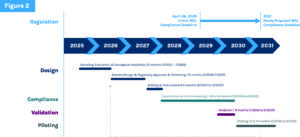
PFAS Policy Shifts: Implications for Public Water Systems
Two recent federal announcements are reshaping the regulatory landscape for per- and polyfluoroalkyl substances (PFAS), prompting providers to revisit their compliance strategies.
Issued on April 28, the first announcement outlines a list of upcoming agency actions aimed at reducing PFAS contamination at the source. These actions include developing effluent limitation guidelines for certain PFAS to minimize discharge into waterways, as well as initiatives to establish a liability framework that safeguards passive receivers and consumers.
Issued on May 14, the second announcement focuses on the liability framework and addresses key compliance challenges for affected water providers.
The following includes answers to frequently asked questions and addresses how the May 14 announcement may influence public water systems (PWSs) planning timelines and the role of professional service providers in supporting such efforts.
Are PFAS regulations still in effect?
PFOA and PFOS drinking water regulations remain unchanged: The National Primary Drinking Water Regulations (NPDWR) for PFOA and PFOS, which set nationwide maximum contaminant level (MCL) of 4 parts per trillion (ppt) for these persistent “forever chemicals,” have not been altered.
What are the recent PFAS regulation changes?
- PFAS compliance deadline extended by two years: PWSs now have until 2031 to comply with PFOA and PFOS regulations. This additional time allows affected providers to meet regulatory requirements more effectively.
- Regulatory reconsideration underway: The Environmental Protection Agency (EPA) announced its intent to rescind certain regulations and reevaluate the determinations for PFHxS, PFNA, HFPO-DA (GenX), and the Hazard Index (HI) mixture of these three substances, as well as PFBS.
- Regulatory updates are forthcoming. The recently announced changes are not yet in effect. The EPA plans to propose a new rule this fall, with finalization expected in the spring of 2026.
Why are the PFAS regulations changing?
- Extended compliance timeline: Water systems now have until 2031 to comply with PFOA and PFOS compliance—two years beyond the previous 2029 requirement.
- Alignment with the Safe Drinking Water Act: The changes aim to align PFAS-related determinations and regulations with the legal framework established by the Safe Drinking Water Act. This applies to the previously set combination of MCL and HI regulations for PFHxS, PFNA, HFPO-DA (GenX), and PFBS.
- Improved communication and outreach: Water systems nationwide, particularly smaller PWSs in rural communities, will receive increased support through a federal exemption framework and enhanced outreach via EPA’s new PFAS OUTreach Initiative (PFAS OUT).
- Accountability for polluters: Regulatory and enforcement mechanisms, including effluent limitation guidelines for PFAS, holds polluters responsible for contamination. The intent is to reduce the financial burden on drinking water systems and lower costs for consumers.
How could these changes impact public water systems?
- PFAS mitigation requirements remain unchanged: The number of PWSs required to implement PFAS mitigation is expected to stay about the same since the primary drivers for mitigation remain in place. Figure 1 presents data from the latest UCMR 5 report, examining different PFAS compounds and PWS sizes.
- Extended compliance timeline provides flexibility: PWSs now have more time to develop and implement mitigation strategies. Those that have yet to start can still meet compliance deadlines if they act soon. However, the compliance path varies based on contaminant type and concentration, selected treatment technologies, site-specific improvement requirements, and industry and market capacity to respond. Figure 2 outlines a general time and action plan.
- More technical assistance for affected systems: EPA’s PFAS OUT will offer increased technical assistance support to help PWSs navigate compliance. Although the prioritization approach hasn’t been released, it is expected to focus on small and rural PWSs.
- Lower PFAS concentrations at the source reduce costs: Limiting PFAS at the source will help lower treatment expenses for PWSs, especially those impacted by identified high-contamination sources.
How can Consor support public water systems?
- Strategic compliance planning: Consor’s water team helps PWSs navigate the extended timeline by developing clear, efficient strategies for implementing mitigation measures.
- Tailored design support and treatment strategy development: Our team provides solutions based on each PWS’s technical, managerial, and financial (TMF) capacity, regardless of size.
- Evaluation and optimization studies: Consor’s experts offer varying levels of PFAS mitigation studies, including:
- Compliance options evaluation
- Feasibility studies
- Accelerated treatability testing
- Funding access support: Our team helps PWSs secure financial resources that support PFAS and other water quality improvement projects. Bringing experience with a variety of funding entities and strategies, we understand the level of effort and detail required to track, apply for, receive, and manage these resources effectively.

Impact of Policy Shifts on the Number of Affected PWSs
Approximately 15% of large and 8% of small PWSs had one or more sampling locations exceeding the MCL for an individual PFAS or HI. Among these, less than 1% (specifically 0.93% of large and 0.52% of small PWSs) recorded exceedances for PFHxS, PFNA, HFPO-DA (GenX), or the HI— contaminants now under regulatory reevaluation, with intent to rescind certain regulations. Figure 1 uses data from the UCMR 5 summary, incorporating the seventh dataset from January 2025, and applies sampling location averages and the MCLs established in the PFAS NPDWR.

Impact of Policy Shifts on Strategic Compliance Planning Timeline
Although the compliance timeline has been extended, PWSs should not delay mitigation efforts—immediate action is necessary to remain on track with the regulations. This plan outlines design, construction, and compliance monitoring timelines, as well as the limited window for piloting studies. If planning begins today, PWSs have fewer than two years to conduct these studies, which must be executed on an accelerated schedule that requires highly skilled professionals.
Moving forward, proactive planning and swift execution will be critical to meet regulatory timelines and protect public health. For tailored strategies, technical expertise, and end-to-end implementation on your PWS, contact Technical Principal, Water Treatment Jasmina Markovski, PhD, PE.
